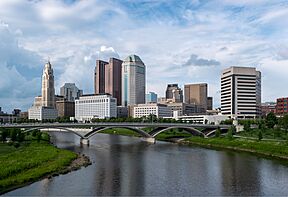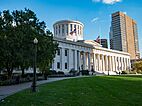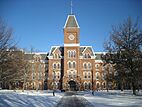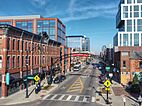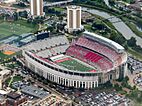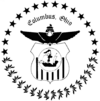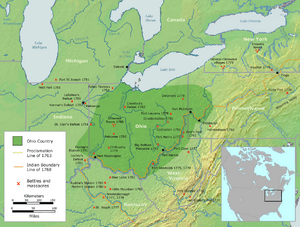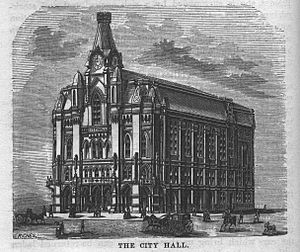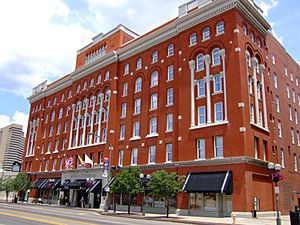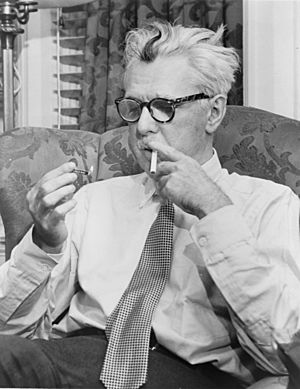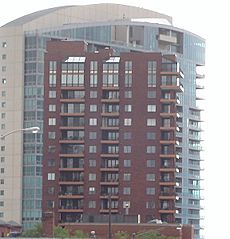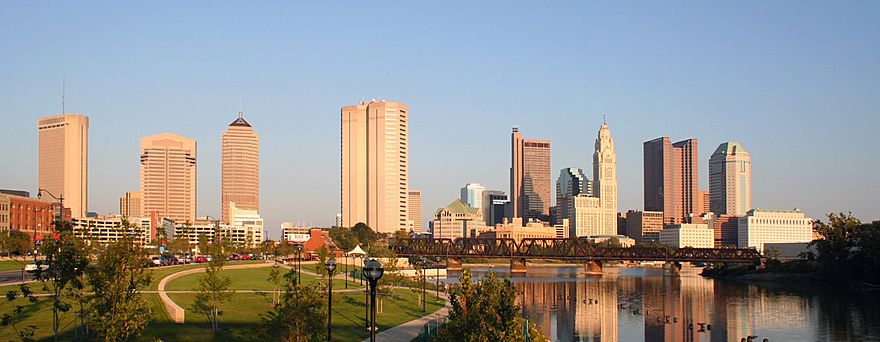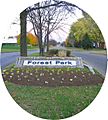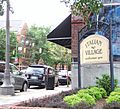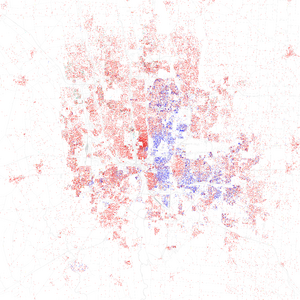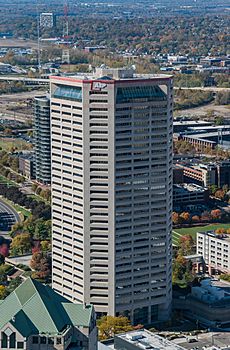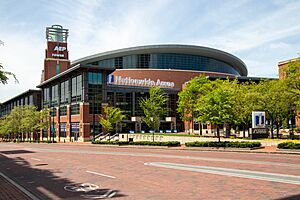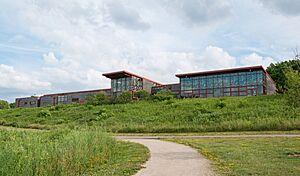Columbus, Ohio facts for kids
Quick facts for kids
Columbus
|
|||||
|---|---|---|---|---|---|
|
Downtown Columbus and the Scioto Mile
Ohio Stadium
|
|||||
|
|||||
| Country | United States | ||||
| State | Ohio | ||||
| Counties | |||||
| Settled | February 14, 1812 | ||||
| Incorporated | February 10, 1816 | ||||
| Named for | Christopher Columbus | ||||
| Government | |||||
| • Type | Mayor–council | ||||
| • Body | Columbus City Council | ||||
| Area | |||||
| • State capital city | 226.26 sq mi (586.00 km2) | ||||
| • Land | 220.40 sq mi (570.82 km2) | ||||
| • Water | 5.86 sq mi (15.18 km2) | ||||
| Elevation | 791 ft (241 m) | ||||
| Population
(2020)
|
|||||
| • State capital city | 905,748 | ||||
| • Estimate
(2023)
|
913,175 | ||||
| • Rank | 41st in North America 14th in the United States 1st in Ohio |
||||
| • Density | 4,109.64/sq mi (1,586.74/km2) | ||||
| • Urban | 1,567,254 (US: 35th) | ||||
| • Urban density | 3,036.4/sq mi (1,172.3/km2) | ||||
| • Metro | 2,138,926 (US: 32nd) | ||||
| Demonym(s) | Columbusite | ||||
| GDP | |||||
| • Metro | 2.088 billion (2023) | ||||
| Time zone | UTC−5 (EST) | ||||
| • Summer (DST) | UTC−4 (EDT) | ||||
| ZIP Codes |
ZIP Codes
|
||||
| Area codes | 614 and 380 | ||||
| FIPS code | 39-18000 | ||||
| GNIS feature ID | 1086101 | ||||
Columbus (/kəˈlʌmbəs/, kə-LUM-bəs) is the capital city of Ohio, a state in the United States. It is also the largest city in Ohio by population. In 2020, about 905,748 people lived there. This makes it the 14th most populated city in the U.S. and the second largest in the Midwest, after Chicago. Columbus is also the third largest state capital city in the U.S., after Phoenix, Arizona and Austin, Texas.
Columbus is the main city of Franklin County. Parts of the city also reach into Delaware and Fairfield counties. It is the center of the Columbus metropolitan area, which includes ten counties in central Ohio. This area had about 2.139 million people in 2020. It is the largest metropolitan area completely within Ohio.
The city of Columbus started as many Native American villages along the Scioto River. Franklinton, which is now a neighborhood in Columbus, was the first European settlement. It was set up in 1797. The city of Columbus itself was founded in 1812 where the Scioto and Olentangy rivers meet. It was planned to be the new state capital. The city was named after the Italian explorer Christopher Columbus. It officially became the state capital in 1816 and the county seat in 1824. Over the years, Columbus grew steadily and became a center for industry. It faced challenges like floods and economic slowdowns. Starting in the 1950s, Columbus grew a lot. By the early 1990s, it became the biggest city in Ohio in both land size and population. This growth has continued into the 21st century, with many parts of the city, including Downtown, being rebuilt and improved.
Columbus has a strong and varied economy. This means it doesn't rely on just one type of business. The area is home to important organizations like the Battelle Memorial Institute, which is the world's largest private research group. It also has Chemical Abstracts Service, which is the biggest place for chemical information. Ohio State University is also here, and it's one of the largest universities in the United States. The Columbus area is also where the main offices of six very large companies (called Fortune 500 companies) are located. These include Cardinal Health, American Electric Power, Bath & Body Works, Inc., Nationwide, Bread Financial and Huntington Bancshares.
Contents
- About the Name of Columbus
- History of Columbus
- Geography of Columbus
- Population of Columbus
- Columbus Economy
- Arts and Culture in Columbus
- Sports in Columbus
- Parks and Fun Places
- Environment
- Education in Columbus
- Media in Columbus
- Transportation in Columbus
- Notable People from Columbus
- Sister Cities
- Images for kids
- See also
About the Name of Columbus
The city of Columbus got its name from the 15th-century Italian explorer Christopher Columbus when it was founded in 1812. It is the largest city in the world named after him. He sailed to and explored parts of the Americas for Spain. There isn't a clear reason why Columbus, who had no direct connection to Ohio, was chosen for the city's name. However, one book suggests that a state lawmaker admired the explorer and convinced others to use the name.
In recent times, there have been discussions about Christopher Columbus's historical actions. These discussions have led to conversations about symbols related to him in the city. For example, in 2018, the city stopped officially celebrating Columbus Day as a city holiday.
Some people have even suggested new names for the city. One idea that became popular in 2020 was "Flavortown." This name would honor celebrity chef Guy Fieri, who was born in Columbus. He liked the idea, even though he didn't suggest it himself. This name also points to Columbus being a place where many new restaurants and food ideas are tested.
Other nicknames for Columbus include "the Discovery City," "Arch City," "Cap City," "Cowtown," "The Biggest Small Town in America," and "Cbus."
History of Columbus
Early Times in Ohio
The land where Columbus is today was once called the Ohio Country. From 1663 to 1763, it was controlled by the French colonial empire. In the 1700s, European traders came to the area for the fur trade.
This area was often a place of conflict between Native American groups and European settlers. In the 1740s, traders from Pennsylvania moved in, but the French forced them out. In the early 1750s, George Washington explored the Ohio Country. Fighting over the land led to the French and Indian War (1754-1763), which was part of a bigger war called the Seven Years' War (1756-1763). The region saw many battles during this time. In 1763, the Treaty of Paris gave the Ohio Country to the British Empire.
After the American Revolution
After the American Revolution, the Ohio Country became part of the United States. Settlers from the East Coast moved in. They met Native American groups like the Miami, Delaware, Wyandot, Shawnee, and Mingo nations, as well as European traders. These tribes did not want the United States to expand onto their lands, which led to many years of fighting.
A big battle called the Battle of Fallen Timbers helped lead to the Treaty of Greenville. This treaty finally opened the way for new settlements. By 1797, a young surveyor from Virginia named Lucas Sullivant started a permanent settlement. It was on the west bank where the Scioto and Olentangy rivers meet. Sullivant admired Benjamin Franklin, so he named his village "Franklinton". The spot was good because it was near rivers that boats could use. However, in 1798, a big flood destroyed the new settlement. Sullivant didn't give up, and the village was rebuilt.
The 1800s in Columbus
When Ohio became a state in 1803, its capital city moved around a few times. State leaders decided they needed a new capital city in the middle of the state. They chose Columbus because it was central and close to important transportation routes like rivers. Before this decision in 1812, Columbus didn't even exist! The city was designed from the start to be the state capital. It was named after Christopher Columbus and founded on February 14, 1812. At that time, the area was a thick forest used for hunting.
The "Burough of Columbus" was officially created on February 10, 1816. Nine people were elected to lead the town. Even though the War of 1812 had brought some good times, a later economic slowdown and land arguments made it hard for the new town to succeed. Early on, conditions were tough, with many people getting sick from fevers and a serious outbreak of cholera in 1833.
The National Road reached Columbus from Baltimore in 1831. This, along with a new connection to the Ohio and Erie Canal, helped the city's population grow quickly. Many European immigrants came to Columbus, creating new communities. A large Irish group settled in the north, and Germans bought cheap land in the south, creating a community known as Das Alte Südende (The Old South End). German people in Columbus built many breweries and schools.
With about 3,500 people, Columbus officially became a city on March 3, 1834. Voters chose John Brooks as the first mayor. Columbus added the nearby city of Franklinton in 1837.
In 1850, the Columbus and Xenia Railroad was the first train line to reach the city. More railroads followed, and by 1875, eight different train lines served Columbus. They built a new, bigger Union Station.
On January 7, 1857, the Ohio Statehouse finally opened after 18 years of building.
Before slavery ended in the South in 1863, the Underground Railroad was active in Columbus. One of its leaders was James Preston Poindexter, a Baptist preacher who helped many African Americans.
During the Civil War, Columbus was an important base for the Union Army. It held 26,000 troops and up to 9,000 Confederate prisoners of war at Camp Chase. More than 2,000 Confederate soldiers are still buried there.
The Ohio State University was founded in 1870. It was first called the Ohio Agricultural and Mechanical College.
By the late 1800s, Columbus had many big factories. It was known as the "Buggy Capital of the World" because of its many buggy factories, like the Columbus Buggy Company. Columbus was also a popular place for workers' groups. In 1886, Samuel Gompers started the American Federation of Labor here. In 1894, James Thurber, a famous writer, was born in the city.
Columbus in the 1900s and Today
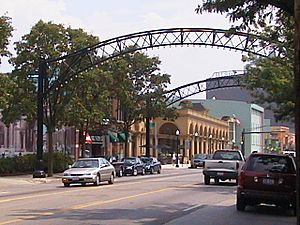
In 1908, Columbus started an important environmental project called "The Columbus Experiment." They built the world's first water plant that could both filter and soften water. This invention greatly reduced deaths from typhoid fever. The basic design is still used today.
Columbus earned one of its nicknames, The Arch City, because of the many wooden arches that stood over High Street around 1900. These arches lit up the street and later provided power to new streetcars. The arches were taken down in 1914, but metal ones were rebuilt in the Short North district in 2002 because of their unique history.
On March 25, 1913, a huge flood, called the Great Flood of 1913, badly damaged the Franklinton neighborhood. Many people died, and thousands lost their homes. To stop future floods, engineers widened the Scioto River, built new bridges, and put up a retaining wall along the riverbanks. After World War I, there was a building boom in the 1920s. This led to a new Civic center, the Ohio Theatre, the American Insurance Union Citadel, and the huge Ohio Stadium. The National Football League (NFL) had its main offices in Columbus from 1921 to 1941.
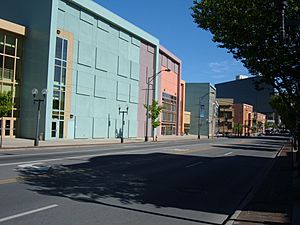
The Great Depression in the 1930s didn't hit Columbus as hard as other cities. This was because Columbus had many different types of businesses. World War II brought many new jobs and more people to the city. Many new people came from the Appalachia region. In 1948, the Town and Country Shopping Center opened nearby, becoming one of the first modern shopping centers in the U.S.
The building of the interstate highways led to fast growth in the suburbs around Columbus. To keep its tax money, Columbus started a plan to connect water and sewer services to new areas if they joined the city. By the early 1990s, Columbus became Ohio's largest city in both land area and population.
In recent years, efforts to improve downtown Columbus have been successful. The Greater Columbus Convention Center has brought many large events to the city. The Scioto Mile is a beautiful park area along the riverfront.

Aviation History
In 1907, a 14-year-old named Cromwell Dixon built a pedal-powered blimp called the SkyCycle and flew it at Driving Park. Three years later, a pilot for the Wright brothers, Phillip Parmalee, made the world's first commercial cargo flight. He flew silk from Dayton to Columbus.
During World War I, six pilots from Columbus, led by ace Eddie Rickenbacker, were very successful. They achieved 42 "kills" (shooting down enemy planes), which was 10% of all U.S. aerial victories in the war.
After the war, Port Columbus Airport (now John Glenn Columbus International Airport) became a key part of a system that moved passengers across the country by combining train and plane travel. Charles Lindbergh helped promote Columbus for this purpose. The airport opened on July 8, 1929. Famous people like Amelia Earhart, Henry Ford, and Harvey Firestone were there for the opening.
In 1964, Ohio native Geraldine Fredritz Mock became the first woman to fly solo around the world. She started her flight from Columbus in her plane, the Spirit of Columbus. Her journey lasted almost a month and set a speed record.
Geography of Columbus
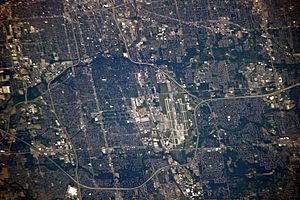
The Scioto and Olentangy rivers meet just northwest of Downtown Columbus. Several smaller rivers and creeks flow through the Columbus area, including Alum Creek, Big Walnut Creek, and Darby Creek. Columbus is mostly flat because a large glacier covered much of Ohio during the Wisconsin Ice Age. However, there are some differences in height across the area. The highest point in Franklin County is about 1,132 feet above sea level near New Albany. The lowest point is about 670 feet where the Scioto River leaves the county near Lockbourne. Many ravines near the rivers and creeks also make the landscape more interesting.
The city covers a total area of about 223.11 square miles. About 217.17 square miles is land, and 5.94 square miles is water.
Columbus Neighborhoods
Columbus Climate
Columbus has a humid continental climate. This means it has hot, humid summers and cold, dry winters. Winter snowfall is usually light. The city is not in the path of big winter storms like those that hit cities farther east. It's also too far south and west for much lake-effect snow from Lake Erie, though the lakes can cause cloudy weather in winter.
The hottest temperature ever recorded in Columbus was 106°F (41°C). This happened twice in the 1930s. The coldest temperature ever recorded was -22°F (-30°C) on January 19, 1994.
Columbus can have severe weather like other parts of the Midwestern United States. Strong thunderstorms can bring lightning, large hail, and sometimes tornadoes, especially in spring and fall. Floods, blizzards, and ice storms can also happen.
| Climate data for Columbus, Ohio (Port Columbus Int'l), 1981–2010 normals, extremes 1878–present | |||||||||||||
|---|---|---|---|---|---|---|---|---|---|---|---|---|---|
| Month | Jan | Feb | Mar | Apr | May | Jun | Jul | Aug | Sep | Oct | Nov | Dec | Year |
| Record high °F (°C) | 74 (23) |
78 (26) |
85 (29) |
90 (32) |
96 (36) |
102 (39) |
106 (41) |
103 (39) |
100 (38) |
91 (33) |
80 (27) |
76 (24) |
106 (41) |
| Mean maximum °F (°C) | 58.7 (14.8) |
63.3 (17.4) |
74.8 (23.8) |
82.2 (27.9) |
87.1 (30.6) |
92.2 (33.4) |
93.5 (34.2) |
92.7 (33.7) |
89.3 (31.8) |
82.1 (27.8) |
71.4 (21.9) |
61.3 (16.3) |
94.9 (34.9) |
| Mean daily maximum °F (°C) | 36.5 (2.5) |
40.6 (4.8) |
51.1 (10.6) |
63.5 (17.5) |
72.9 (22.7) |
81.6 (27.6) |
84.9 (29.4) |
83.7 (28.7) |
77.0 (25.0) |
65.1 (18.4) |
52.6 (11.4) |
40.1 (4.5) |
62.6 (17.0) |
| Mean daily minimum °F (°C) | 22.6 (−5.2) |
25.0 (−3.9) |
32.7 (0.4) |
42.6 (5.9) |
52.2 (11.2) |
61.5 (16.4) |
65.5 (18.6) |
64.1 (17.8) |
56.5 (13.6) |
45.0 (7.2) |
36.1 (2.3) |
26.8 (−2.9) |
44.3 (6.8) |
| Mean minimum °F (°C) | 0.8 (−17.3) |
5.5 (−14.7) |
13.8 (−10.1) |
26.0 (−3.3) |
36.9 (2.7) |
47.2 (8.4) |
53.0 (11.7) |
52.3 (11.3) |
40.6 (4.8) |
29.9 (−1.2) |
20.4 (−6.4) |
7.4 (−13.7) |
−3.4 (−19.7) |
| Record low °F (°C) | −22 (−30) |
−20 (−29) |
−6 (−21) |
14 (−10) |
25 (−4) |
35 (2) |
43 (6) |
39 (4) |
31 (−1) |
17 (−8) |
−5 (−21) |
−17 (−27) |
−22 (−30) |
| Average precipitation inches (mm) | 2.73 (69) |
2.25 (57) |
3.02 (77) |
3.40 (86) |
4.17 (106) |
4.01 (102) |
4.79 (122) |
3.32 (84) |
2.84 (72) |
2.61 (66) |
3.20 (81) |
2.97 (75) |
39.31 (998) |
| Average snowfall inches (cm) | 9.2 (23) |
6.1 (15) |
4.2 (11) |
1.1 (2.8) |
trace | 0 (0) |
0 (0) |
0 (0) |
0 (0) |
0.2 (0.51) |
0.9 (2.3) |
5.0 (13) |
26.7 (68) |
| Average precipitation days (≥ 0.01 in) | 14.0 | 11.4 | 12.8 | 13.7 | 13.9 | 11.2 | 10.6 | 9.2 | 8.4 | 9.4 | 11.4 | 13.2 | 139.2 |
| Average snowy days (≥ 0.1 in) | 9.1 | 6.6 | 4.5 | 1.2 | 0 | 0 | 0 | 0 | 0 | 0.1 | 1.8 | 6.5 | 29.8 |
| Average relative humidity (%) | 71.4 | 69.5 | 64.5 | 62.5 | 66.5 | 68.5 | 70.6 | 72.8 | 72.8 | 69.3 | 71.8 | 74.1 | 69.5 |
| Mean monthly sunshine hours | 110.6 | 126.3 | 162.0 | 201.8 | 243.4 | 258.1 | 260.9 | 235.9 | 212.0 | 183.1 | 104.2 | 84.3 | 2,182.6 |
| Percent possible sunshine | 37 | 42 | 44 | 51 | 55 | 57 | 57 | 56 | 57 | 53 | 35 | 29 | 49 |
| Source: NOAA (sun 1961–1990) | |||||||||||||
Population of Columbus
| Historical population | ||
|---|---|---|
| Year | Pop. | ±% |
| 1812 | 300 | — |
| 1820 | 1,450 | +383.3% |
| 1830 | 2,435 | +67.9% |
| 1840 | 6,048 | +148.4% |
| 1850 | 17,882 | +195.7% |
| 1860 | 18,554 | +3.8% |
| 1870 | 31,274 | +68.6% |
| 1880 | 51,647 | +65.1% |
| 1890 | 88,150 | +70.7% |
| 1900 | 125,560 | +42.4% |
| 1910 | 181,511 | +44.6% |
| 1920 | 237,031 | +30.6% |
| 1930 | 290,564 | +22.6% |
| 1940 | 306,087 | +5.3% |
| 1950 | 375,901 | +22.8% |
| 1960 | 471,316 | +25.4% |
| 1970 | 539,677 | +14.5% |
| 1980 | 564,871 | +4.7% |
| 1990 | 632,910 | +12.0% |
| 2000 | 711,470 | +12.4% |
| 2010 | 787,033 | +10.6% |
| 2020 | 905,748 | +15.1% |
| 2023 est. | 913,175 | +0.8% |
| 1812, 1820-2019: U.S. Census Source: |
||
2020 Census Information
In the 2020 United States census, Columbus had 905,748 people and 362,626 households.
The population was made up of different groups:
- 57.4% White
- 29.2% Black or African American
- 0.2% Native American or Alaska Native
- 5.9% Asian
- 6.3% Hispanic or Latino (of any race)
Population Growth and Diversity
Columbus has always grown in population since it was founded. Its slowest growth was from 1850 to 1860, mainly because of a cholera sickness in the 1850s.
Columbus has a very diverse population. Many people from different countries have moved here, especially from Africa, Asia, and Latin America. This includes groups from Mexico, India, Nepal, Bhutan, Somalia, and China. Columbus has one of the largest Somali populations in the U.S. and the largest Bhutanese-Nepali population in the world.
Because Columbus has a mix of different people and income levels, it is often called a "typical" American city. This is why many stores and restaurants use Columbus as a test market for new products before selling them everywhere.
Italian-American Community
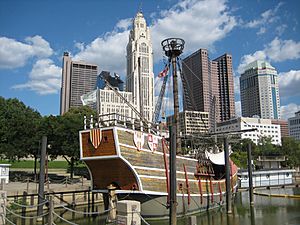
Columbus has many Italian Americans. Groups like the Columbus Italian Club help keep their heritage alive. The Italian Village neighborhood near downtown has been home to a strong Italian American community since the 1890s.
The Italian American community has helped share the history of Christopher Columbus and his voyages. The city is named after him, and its flag and seal show a ship he used, the Santa María. A replica of this ship, the Santa Maria Ship & Museum, was displayed downtown for many years. The city's Discovery District and Discovery Bridge are also named after Columbus's "discovery" of the Americas. Genoa Park, downtown, is named after Genoa, Italy, which is Christopher Columbus's birthplace and one of Columbus's sister cities.
In 1992, Columbus celebrated the 500th anniversary of Columbus's first voyage with a big event called AmeriFlora '92. There have been discussions about the statues of Christopher Columbus in the city. In 2020, one statue at City Hall was removed.
Religion in Columbus
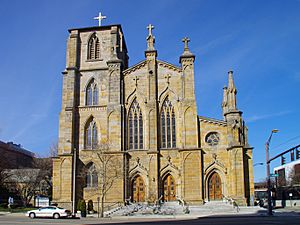
Many different religions are practiced in Columbus. About 26% of people in the Columbus area do not identify with a specific religion. The rest belong to various faiths, including:
- White evangelical Protestants
- White mainline Protestants
- Black Protestants
- White Catholics
- Hispanic Catholics
- Asian, Hindu, Buddhist, Jewish, and Muslim communities
There are many places of worship, including churches, Islamic centers, Jewish synagogues, Buddhist centers, and Hindu temples. Columbus also has religious schools like the Pontifical College Josephinum.
Columbus Economy
Columbus has a strong and varied economy. This means it has many different types of jobs and businesses. These include education, insurance, banking, fashion, defense, aviation, food, shipping, steel, energy, medical research, health care, hotels, retail, and technology. In 2010, it was named one of the 10 best big cities in the country for living.
Because Columbus is the state capital, many government jobs are in the city. These jobs are the largest source of employment in Columbus.
In 2019, six very large companies (called Fortune 500 companies) had their main offices in the Columbus area. These include Cardinal Health, American Electric Power, Bath & Body Works, Inc., Nationwide, Bread Financial and Huntington Bancshares. Other big employers are schools like Ohio State University and hospitals like Wexner Medical Center and Nationwide Children's Hospital. Research groups like the Battelle Memorial Institute and information companies like Chemical Abstracts Service are also important. Many foreign companies also have offices or factories here. Columbus is also a center for fashion and retail, with companies like Big Lots and Abercrombie & Fitch.
Food and Beverage Industry
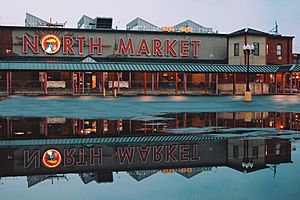
The North Market, a public market and food hall, is located downtown. It is the only one left of Columbus's original four marketplaces.
Many restaurant chains started in the Columbus area, such as Charleys Philly Steaks, Bibibop Asian Grill, Steak Escape, White Castle, and Wendy's. Wendy's, one of the world's largest hamburger chains, used to have its first store downtown as a museum and restaurant. Budweiser has a large brewery on the north side of the city. Columbus also has many local breweries and pubs.
Arts and Culture in Columbus
Famous Buildings and Places

Columbus has more than 170 important buildings listed on the National Register of Historic Places. The city also has its own list of historic properties. There are four historic neighborhoods: German Village, Italian Village, Victorian Village, and the Brewery District.
Building the Ohio Statehouse started in 1839 on a 10-acre piece of land. It was built using Columbus limestone. The Statehouse opened to the public in 1857 and was finished in 1861. It is located at the corner of Broad and High streets in downtown Columbus.
The original home of Eddie Rickenbacker, a World War I fighter pilot, is in the Driving Park area. Built in 1895, it was named a National Historic Landmark in 1976.
Museums and Public Art
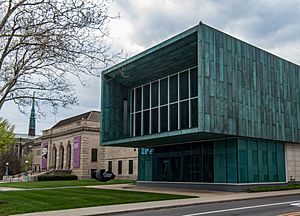
Columbus has many museums and art galleries. The main art museum is the Columbus Museum of Art. It shows American and European art, including Impressionism and Cubism. Another important art museum is the Wexner Center for the Arts, which is a contemporary art gallery at Ohio State University.
The Ohio History Connection is based in Columbus. Its main museum, the Ohio History Center, is north of downtown. Next to it is Ohio Village, which looks like a village from the time of the American Civil War. The Columbus Historical Society also has exhibits about life in Columbus.
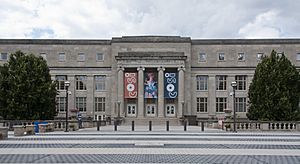
COSI is a large science and children's museum in downtown Columbus. It opened in 1999. In 2009, Parents magazine called COSI one of the 10 best science centers for families in the country. Other science museums include the Orton Geological Museum and the Museum of Biological Diversity, both at Ohio State University.
The Franklin Park Conservatory is the city's botanical garden, which opened in 1895. It has over 400 types of plants in a large glass greenhouse. The conservatory is just east of Downtown in Franklin Park.
Other museums include the Thurber House (about cartoonist James Thurber), the Jack Nicklaus Museum (about the golfer), and the Kelton House Museum and Garden, which shows Victorian life and was a stop on the Underground Railroad.
The National Veterans Memorial and Museum, which opened in 2018, tells the personal stories of military veterans throughout U.S. history.
Performing Arts

Columbus is home to many performing arts groups. These include the Columbus Symphony Orchestra, Opera Columbus, BalletMet Columbus, and the ProMusica Chamber Orchestra. In the summer, the Actors' Theatre of Columbus performs free Shakespearean plays in Schiller Park in German Village.
Columbus has several large places for concerts, such as the Nationwide Arena, Value City Arena, and the Newport Music Hall.
In 2009, the Lincoln Theatre, which was once a center for Black culture, reopened after being restored. The King Arts Complex also hosts cultural events. Downtown, there are historic theaters like the Palace Theatre, the Ohio Theatre, and the Southern Theatre.
Movies Filmed in Columbus
Some movies filmed in the Columbus area include Teachers (1984), Tango & Cash (1989), Little Man Tate (1991), Air Force One (1997), and Traffic (2000). The 2018 movie Ready Player One is set in Columbus, but it was not filmed here.
Sports in Columbus
| Club | League | Sport | Venue (capacity) | Founded | Titles | Average Attendance |
|---|---|---|---|---|---|---|
| Ohio State Buckeyes | NCAA | Football | Ohio Stadium (104,851) | 1890 | 8 | 105,261 |
| Columbus Crew | MLS | Soccer | Lower.com Field (20,371) | 1996 | 3 | 20,646 |
| Ohio State Buckeyes | NCAA | Basketball | Value City Arena (19,000) | 1892 | 1 | 16,511 |
| Columbus Blue Jackets | NHL | Ice hockey | Nationwide Arena (18,500) | 2000 | 0 | 16,659 |
| Columbus Clippers | IL | Baseball | Huntington Park (10,100) | 1977 | 11 | 9,212 |
| Columbus Crew 2 | MLS Next Pro | Soccer | Historic Crew Stadium (19,968) | 2022 | 1 | N/A |
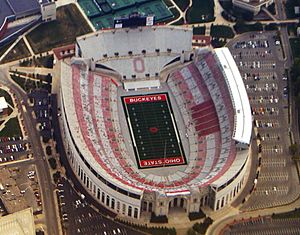

Professional Sports Teams
Columbus has two major professional sports teams:
- The Columbus Blue Jackets play Ice hockey in the National Hockey League (NHL) at Nationwide Arena.
- The Columbus Crew play Soccer in Major League Soccer (MLS) at Lower.com Field. The Crew was one of the first MLS teams and has won the MLS Cup three times (in 2008, 2020, and 2023).
The Columbus Clippers, a minor league Baseball team, play at Huntington Park. They are connected to the Cleveland Guardians.
Columbus was also home to the Columbus Panhandles football team from 1901 to 1926. They are known for playing in the first NFL game against another NFL team.
Ohio State Buckeyes
Columbus is home to the Ohio State Buckeyes, the sports teams of Ohio State University. This is one of the best college sports programs in the country. The university has 36 different sports teams.
The Ohio State Buckeyes are part of the NCAA's Big Ten Conference. Their football team plays home games at Ohio Stadium. The football game between Ohio State and Michigan is a huge rivalry and is played every November. Many people in Columbus are big fans of the Buckeyes all year round.
The Buckeyes' basketball and hockey teams are also very popular during the winter.
Other Sports
Columbus has a long history with motorsports. The world's first 24-hour car race was held at the Columbus Driving Park in 1905. The Columbus Motor Speedway opened in 1945.
The annual All American Quarter Horse Congress, the world's largest horse show for one breed, brings about 500,000 visitors to the Ohio Expo Center every October.
Columbus also hosts the yearly Arnold Sports Festival. This event, led by Arnold Schwarzenegger, includes many different sports and attracts thousands of athletes.
Parks and Fun Places
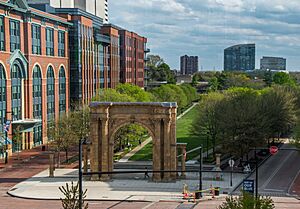
Columbus has about 370 city parks, managed by the Recreation and Parks Department. There are also 19 regional parks and the Metro Parks in the area.
Some popular parks include:
- Whetstone Park in Clintonville, which has the Columbus Park of Roses, a 13-acre rose garden.
- The Chadwick Arboretum at Ohio State's campus, with many different plants.
- The Topiary Park downtown, which has plants shaped to look like a famous painting.
- The Scioto Audubon Metro Park, which opened in 2009 and has a nature center for birdwatching.
The Columbus Zoo and Aquarium has many animals, including gorillas, polar bears, and tigers. The zoo complex also includes the Zoombezi Bay water park.
Festivals and Events

Columbus hosts many annual events:
- The Ohio State Fair is one of the largest state fairs in the country. It happens in late July to early August.
- The Columbus Arts Festival and the Jazz & Rib Fest are held on the downtown riverfront.
- The Sonic Temple Art & Music Festival is a big rock music festival in May.
- The Park Street Festival in early June is a large party in the North Market District.
- Columbus Pride in late June is one of the Midwest's largest gay pride parades.
- ComFest (Community Festival) in late June is a huge three-day music festival with art, music, and community groups.
- Restaurant Week Columbus happens twice a year, offering special deals at many restaurants.
- Around the Fourth of July, Columbus has Red, White & Boom!, a huge fireworks show on the Scioto riverfront.
- The Short North neighborhood has a monthly Gallery Hop, where art galleries stay open late.
- German Village holds an annual Oktoberfest in late September with German food, beer, and music.
The Greater Columbus Convention Center hosts many conventions and trade shows. It was designed by architect Peter Eisenman.
Shopping in Columbus
Columbus has two major shopping centers: Easton Town Center and Polaris Fashion Place.
Older malls like Westland, Northland, and Eastland were built in the 1960s. Columbus City Center was built downtown in 1988 but closed in 2009.
Environment
The City of Columbus is working to reduce its environmental impact and carbon footprint. In 2020, voters approved a plan for Columbus to use 100% renewable energy by 2023. This will come from new wind and solar farms in Ohio.
The biggest sources of pollution in the county are Ohio State University's McCracken Power Plant, the landfill, and the Anheuser-Busch brewery. These organizations are working to reduce their emissions.
Education in Columbus
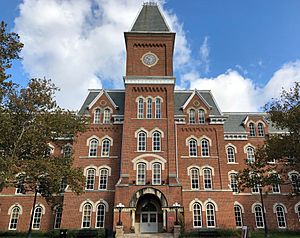
Colleges and Universities
Columbus is home to two public colleges:
- The Ohio State University, which is one of the largest college campuses in the United States. It is known as a top public university.
- Columbus State Community College.
There are also several private colleges, including the Columbus College of Art and Design, Franklin University, and religious schools like Ohio Dominican University.
Schools for Kids
Columbus City Schools (CCS) is the largest school district in Ohio, with about 55,000 students. It runs 142 elementary, middle, and high schools.
Many suburbs around Columbus have their own school districts. The Roman Catholic Diocese of Columbus also runs several private Catholic schools.
Some sources say that the first kindergarten in the United States was started in Columbus in 1838 by Louisa Frankenberg. Also, Indianola Junior High School (now Graham Elementary and Middle School) became the nation's first junior high school in 1909.
Libraries
The Columbus Metropolitan Library (CML) has been serving central Ohio since 1873. It has 23 locations and over 3 million items. This library system is one of the most used in the country and is often ranked among the best large city libraries. CML was ranked the No. 1 library system in the U.S. in 1999, 2005, and 2008.
Media in Columbus
Several newspapers serve Columbus. The main daily newspaper is The Columbus Dispatch. There are also local papers for different neighborhoods and suburbs. The Lantern and 1870 are for the Ohio State University community. For arts and culture, there's ALIVE and Columbus Underground (online only). Magazines include Columbus Magazine and Columbus Monthly.
Columbus has 12 television stations and is a large television market. It is also a significant radio market.
Transportation in Columbus
Roads and Highways
The two main streets in Columbus are Broad and High Streets. They cross in downtown Columbus, which is the center of the city's street plan. North-south streets run parallel to High Street, and avenues run east-west.
The address system starts at the intersection of Broad and High streets. Numbers get bigger as you move away from these streets. Even-numbered addresses are on the north and east sides of streets, and odd addresses are on the south and west sides.

Columbus has two major Interstate Highways: Interstate 70 (east-west) and Interstate 71 (north-south). They meet downtown in an area called "The Split," which can get very busy during rush hour. The Interstate 270 Outerbelt goes around most of the city. Because of its central location and many roads, most places in Ohio are within a two- or three-hour drive from Columbus.
Bridges
Columbus has several bridges over its rivers. The Discovery Bridge connects downtown to Franklinton. The 700-foot Main Street Bridge opened in 2010 and has lanes for cars, pedestrians, and bikes. The Rich Street Bridge opened in 2012. The Lane Avenue Bridge is a cable-stayed bridge that opened in 2003 in the University District.
Airports
The main airport is John Glenn Columbus International Airport, on the east side of the city. It offers flights to many places in the U.S. and some international destinations. Rickenbacker International Airport, south of Columbus, is a major cargo airport. Ohio State University Don Scott Airport and Bolton Field are other airports for general aviation.
Aviation History (Repeated from History Section)
In 1907, a 14-year-old named Cromwell Dixon built a pedal-powered blimp called the SkyCycle and flew it. Three years later, a pilot for the Wright brothers, Phillip Parmalee, made the world's first commercial cargo flight. He flew silk from Dayton to Columbus.
During World War I, six pilots from Columbus, led by ace Eddie Rickenbacker, were very successful. They achieved 42 "kills" (shooting down enemy planes).
After the war, Port Columbus Airport (now John Glenn Columbus International Airport) became a key part of a system that moved passengers across the country by combining train and plane travel. Charles Lindbergh helped promote Columbus for this purpose. The airport opened on July 8, 1929. Famous people like Amelia Earhart, Henry Ford, and Harvey Firestone were there for the opening.
In 1964, Ohio native Geraldine Fredritz Mock became the first woman to fly solo around the world. She started her flight from Columbus in her plane, the Spirit of Columbus. Her journey lasted almost a month and set a speed record.
Public Transportation
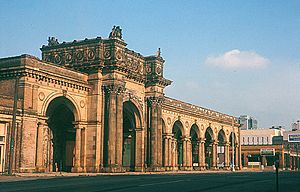
Columbus has a bus service called the Central Ohio Transit Authority (COTA). It has many routes and serves millions of passengers each year. COTA is planning to add more fast transit options in the future.
You can also take intercity buses from the Columbus Bus Station with companies like Greyhound.
Columbus does not have passenger train service. Its main train station, Union Station, was torn down in 1979. Columbus is now the largest city in the U.S. without any passenger train service. However, there are plans to bring train service back to Columbus by 2035.
Biking in Columbus
Biking is becoming more popular in Columbus because the city is mostly flat and has many bike paths. The city has a plan to improve bike paths. Groups like Bike to Work Week and Yay Bikes encourage cycling.
The Main Street Bridge, which opened in 2010, has a special lane just for bikes and walkers.
Columbus also has a public bike system called CoGo Bike Share. It has about 600 bikes and 80 places to pick up or drop off bikes. Electric scooters are also available.
Notable People from Columbus
Sister Cities
Columbus has 10 sister cities around the world. These are cities that Columbus has a special friendship with. Columbus's first sister city was Genoa, Italy, in 1955. Genoa gave Columbus a bronze statue of Christopher Columbus. This statue was in front of Columbus City Hall from 1955 until 2020, when it was removed.
Here are Columbus's sister cities:
 Genoa, Italy (1955)
Genoa, Italy (1955) Tainan, Taiwan (1980)
Tainan, Taiwan (1980) Hefei, China (1988)
Hefei, China (1988) Odense, Denmark (1988)
Odense, Denmark (1988) Seville, Spain (1988)
Seville, Spain (1988) Dresden, Germany (1992)
Dresden, Germany (1992) Herzliya, Israel (1996)
Herzliya, Israel (1996) Ahmedabad, India (2008)
Ahmedabad, India (2008) Curitiba, Brazil (2014)
Curitiba, Brazil (2014) Accra, Ghana (2015)
Accra, Ghana (2015)
Images for kids
-
Legendary Columbus native James Thurber, subject of TIME Magazine's July 9, 1951, cover
-
Street arches returned to the Short North in late 2002
-
Columbus Convention Center, downtown
-
Columbus artist James Mason's French Topiary Gardens at the Old Deaf School Park, constructed in 1989 in downtown, was conceptually conceived from Georges Seurat's A Sunday Afternoon on the Island of La Grande Jatte.
-
Charles Lindbergh visited in 1928 for an aviation campaign.
-
John Glenn Columbus International Airport taken from the International Space Station
-
The Santa Maria Ship & Museum, a Santa María replica, was docked downtown from 1991 to 2014.
-
St. Joseph Cathedral, seat of the Roman Catholic Diocese of Columbus
-
The Art Deco LeVeque Tower is the city's second-tallest skyscraper.
-
The Columbus Museum of Art collects and exhibits American and European modern and contemporary art, folk art, glass art, and photography.
-
COSI (east entrance pictured) features themed, interactive science exhibits.
-
Ohio Stadium, on the campus of Ohio State University, is the 5th-largest non-racing stadium in the world.
-
Nationwide Arena, home of the NHL's Columbus Blue Jackets
-
Lower.com Field, the current home of the Columbus Crew
-
The Ohio State Fair is held in late July to early August.
-
Located in the Arena District, McFerson Commons is home to the Union Station arch.
-
The Scioto Mile includes nine parks along both banks of the Scioto River between downtown Columbus and Franklinton.
-
Audubon nature center at Scioto Audubon Metro Park, the first built close to a major city's downtown
-
University Hall at the Ohio State University
-
I-71, part of the innerbelt around downtown, bridged by numerous overpasses
-
Arcade of the third Union Station, the city's rail station from 1897 to 1977
See also
 In Spanish: Columbus (Ohio) para niños
In Spanish: Columbus (Ohio) para niños


